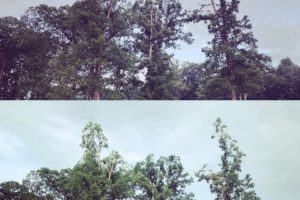We recently worked on a project that involved crown cleaning maturing trees along a long country estate driveway. The driveway wandered up a moderate hill past Tamarack, White Pine, Hemlock, Sugar Maple, Red and White Oak, and a few young Beech. Most leaves had dropped, but the oranges of the Tamarack and Beech warmed an otherwise cooling fall, and they lit the way. Old stone walls were latticed through the forest, marking the edges of old fields and pastures quilted into the side of this knoll in the topography, out of which the young woods grew. I hear the words of Wendell Berry, “The young woodland remembers the old, a dreamer dreaming.”
At the top of one White Pine I climbed, I came across a shear plane crack in a smaller scaffold limb approximately four inches in diameter and fifteen feet in length. The longitudinal separation occurred along the seam where compression wood had formed on the under half of the branch. I noted the ‘buckled’ effect of the limb as daylight shined through an otherwise physiologically functioning organ. There was ample woundwood curling around the margins of the crack. Respiration and photosynthesis were still reciprocating. Cells continued to divide and grow and specialize. Water transported sucrose from the photosynthetic center of the needles down through the stem in the phloem to storage sites in the sapwood and roots. Although a buckled branch, form did not buckle function, so to speak. So I made a reduction cut at the end of the branch, two inches in diameter, in an attempt to relieve some of the pressure on the healing crack, in order to preserve the ongoing function in light of the form that I found.

Shigo gave us the image of the tree system acting as a seesaw in order to illustrate his concept of dynamic equilibrium. He wrote, “dynamic equilibrium is a situation where two opposing processes are moving back and forth at a steady rate,” (Modern Arboriculture, 298). He notes that this dynamic equilibrium is very different from balance in the sense that the former is life giving(a highly organized system functioning properly), while the latter leads to death (system failure). Constant motion in the mode of reciprocation and oscillation is therefore what the arborist should note and aim to preserve.
Arborists oftentimes deal specifically with parts of the whole in the context of preservation. Two basic examples would be dead or dying branche(s), or a cracked limb or stem. These problems exist at the physiological level or at the bio-mechanical level; and potentially both spheres overlap. In the White Pine I referenced already, I dealt with dead limbs (physiological failures) and a cracked limb (biomechanical failure). Each embodies some sense of stress or strain on the system. But these individual parts can experience strain while the system at large maintains a state of dynamic equilibrium. It’s the nature of a highly organized and dynamic system. It’s characteristic of vigor. Therefore, the state of individual tree parts is not necessarily representative of the health/stability of the larger tree system. This notion illustrates the complexity of trying to grasp the concept of dynamic equilibrium. The constant coming and going of life and death in a maturing tree.
I think again of a poem by Berry titled ‘The Sycamore’. Not only is it beautiful verse, but I think it gets to the heart of this idea of dynamic equilibrium in a beautiful way. “In the place that is my own place, whose earth I am shaped in and must bear, there is an old tree growing, a great sycamore that is a wondrous healer of itself…There is no year it has flourished in that has not harmed it. There is a hollow in it that is its death, though its living brims whitely at the lip of the darkness and flows outward. Over all its scars has come the seamless white of the bark. It bears the gnarls of its history healed over…I see that it stands in its place, and feeds upon it, and is fed upon, and is native, and maker,” (Berry, The Pease of Wild Things, 20).

I would suggest anyone to read the poem in its entirety, for it is a short and beautifully simple description of the complex life and character of an old tree. Even more, it is a great characterization of what Shigo describes as dynamic equilibrium, the oscillating seesaw action of life, of stress and strain, of shedding and regrowth, of giving and taking. We can look at trees and observe almost constant change and constant motion, which is hard to conceive when considering an organism that exists in one individual place throughout the range of its life. But a tree embodies the harmony of its place, and is a reflection of the community around it. And trees give arborists a sense of place. And a sense of purpose. Berry writes that the tree is actually “a principle, an indwelling…that I would be ruled by.”
I think that is arboriculture.





Leave a Reply
Your email is safe with us.